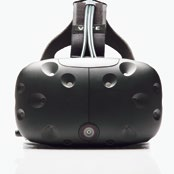The path to virtual reality is filled with forsaken hardware and broken dreams. Why is everyone trying to make it a thing?


The path to virtual reality is filled with forsaken hardware and broken dreams. Why is everyone trying to make it a thing?

More inside>
Canon dreams of the future
A host of new tech at the canon expo in shanghai
Q&A
Erik Johansson
Johansson creates magical new worlds with photography and photoshop

2016 is supposed to be VR’s year
Big names are betting on virtual reality to be The Next Big Thing.
Virtual reality has been a dream for decades — a dream wrecked by failures. The last time VR fantasies reached fever pitch was in the 1990s, which culminated in the debut of the Nintendo Virtual Boy. The technology just wasn’t ready, and the Virtual Boy was discontinued a year after its launch.
Consumer VR went dark for a while, but hope never really went away. 2016’s virtual reality resurgence can be traced back to one fundraiser in 2012, when Oculus VR launched a Kickstarter campaign to build development kits of its Rift, a VR headset for immersive gaming.
The campaign ignited, and it raised US$2.4 million, almost 1,000% of its original US$250,000 target. Two years later, Facebook bought Oculus VR for US$2 billion, near 1,000% of its Kickstarter funding. The big purchase cemented the surge to make VR a thing.
But why is Facebook, a social networking service, getting into VR? Why are Apple, Google, HTC, LG, Microsoft and Samsung, for that matter?
The simplest answer is the desire to conquer and command the next platform in consumer technology. If there’s anything the last 40 years of personal computers has taught us, it’s that there is great power and profit when you’re the dominant platform.
Microsoft proved this in the late 20th to early 21st century in the PC wars — its closest competitor, Apple, almost rotted to death, while Microsoft made billions with the ascendance of Windows.
The smartphone wars of the last decade not only reaffirmed how an assertive, proprietary platform could cement your position in the market, it also revealed three things.
One, platform wars are fought and won much more quickly today. Two, that having a strong software platform isn’t enough anymore, you need to lock it into hardware you own for maximum profit (i.e. iPhone and iOS). Three, even the upstart can become a king (i.e. Apple), and even kings can die (i.e. Nokia).
With the kings for the PC, mobile and social networking platforms already established, tech companies have their eyes out for the next major kingdom to rule over; keenly aware that missing out could mean becoming the next RIM.
Is VR really going to be the next big thing? 2016 is the year when the two biggest VR headsets, the Oculus Rift and the HTC Vive, finally go on sale to the mass market, and the jury is still out. Virtual reality could turn out to be the new smartphone — or just another Virtual Boy.
Who’s Who in the VR World
Apple
Apple is rumored to be secretly working on VR. When asked about VR, CEO Tim Cook has said, “ … I don’t think it’s a niche. It’s really cool and has some interesting applications.”
Facebook/Oculus VR
Facebook acquired Oculus VR in 2014, and has since bought two more VR companies, Surreal Vision and Two Big Ears. Oculus partnered with Samsung to develop the Gear VR.
Google has a new VR platform, called Daydream, which is built on top of Android N. Daydream-ready phones are scheduled to ship Q3 of 2016.
HTC/Valve
HTC’s Vive is the only other major ‘serious’ VR headset besides the Oculus Rift. Thanks to its partnership with Valve, the Vive is shipping with a big game catalog and gaming API.
NextVR
NextVR broadcasts live VR content, and has streamed boxing matches, debates, and the Daytona 500 via the Oculus app on Samsung Gear VR. It’s planning to stream more sports and concerts in the near future.
Samsung
Samsung’s Gear VR, developed with Oculus VR, is the best mobile VR experience you can get today. Compared to the Rift and Vive, the Gear VR offers a wire-free experience without the need for a PC.
Sony
Sony will launch the PlayStation VR later this year. The company has expertise and experience with consumer electronics, which could give its headset an edge.
The VR Sets You Can Buy in 2016

Google Cardboard
The least expensive way to get a taste of Vr. cardboard is what it sounds like, a cardboard viewer that mounts compatible smartphones.

Samsung Gear Vr
The Gear Vr comes with optics and sensors and is the best way to get into mobile Vr. But it only works with compatible samsung smartphones.

Oculus Rift
The rift comes with over 100 game titles planned for release in 2016. it uses an Xbox One controller, its motiontracking controllers will ship later this year.

Htc Vive
More expensive than the rift, but the Vive also comes with wireless motion-tracking controllers, and motiontracking sensors for your room.

Playstation Vr
The rift and the Valve need (very) high-end pc rigs to play, but the playstation Vr is built to play with sony’s ps4. scheduled for release end 2016.























